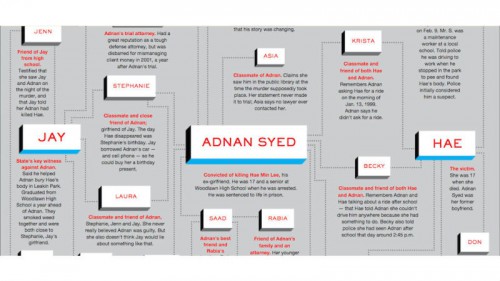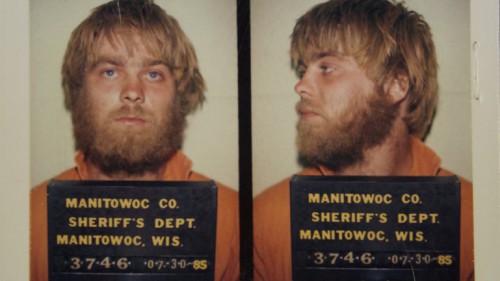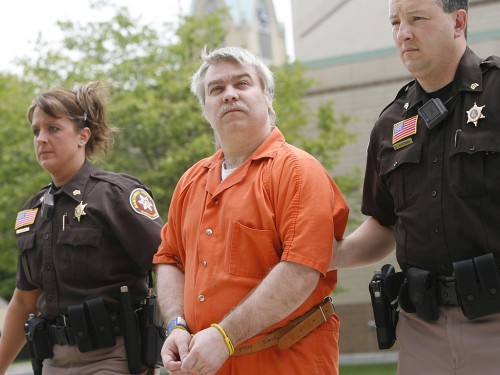
NOTE: I tried not to give spoilers. I did not succeed.
When my husband, Alex, noticed Making a Murderer on our ‘Recently Watched’ Netflix, he shot me an all-too-familiar look. It’s a glare mixed with skepticism, disappointment, and a touch of amused confusion at the woman he didn’t realize I was when we married several years ago.
“Really?” he says with a perceptible smile. I pull the blanket up over my face.
“Is this show going to affect you?” – a sentence uttered often from Alex. What he’s really asking: “Is this show going to keep you (therefore me) up all hours of the night, send you into therapy, and lead you to write condolence letters to people you’ve never met?”
This is Serial all over again.
 Making a Murderer has had a serious impact on me. The show is a ten-episode documentary series filmed by Laura Ricciardi and Moira Demos over a period of ten years. It follows the remarkable story of Steven Avery – a poor, uneducated man from rural Manitowoc County, Wisconsin.
Making a Murderer has had a serious impact on me. The show is a ten-episode documentary series filmed by Laura Ricciardi and Moira Demos over a period of ten years. It follows the remarkable story of Steven Avery – a poor, uneducated man from rural Manitowoc County, Wisconsin.
Here’s the framework: In 1985 Steven, age 22, is convicted of a rape and attempted murder he did not commit. He spends 18 years in prison before the Wisconsin Innocence Project takes on his case and exonerates him of the charges. A problem: once people have spent so long viewing you as a rapist and attempted murderer, it’s hard for them to forget it isn’t true.
Steven is released in 2003. He has lost 18 years of his life due to (at best) shockingly careless police proceedings, or (at worst) appalling mal-intent on the part of the Manitowoc Sheriff’s Department.
With good reason, Steven files a $36 million federal lawsuit against the county, its former sheriff, and its former district attorney.
Only several days after critical depositions in the lawsuit from key players in Steven’s 1985 arrest, a young photographer named Teresa Halbach goes missing. The last person to see her? Steven Avery on his family’s auto-salvage yard. She had come by to take pictures of a van they planned to advertise in Auto Trader Magazine.
Immediately, the investigation into Teresa’s whereabouts is focused almost entirely on Steven. Not her roommate (who failed to report her missing for several days). Not her ex-boyfriend. Not on family members or other acquaintances. All eyes are on Steven. After all, he is a rapist. Or wait…no he isn’t. But he sort of looks like one and his family is dirty and loud and chock-full of chronic misbehavers. He probably did it, right?
The Avery property is searched over by officers from neighboring Calumet County, since there’s a conflict of interests in Manitowoc. Then it’s searched again, and only after police have turned the place upside down several times do they find the key to Teresa’s car in suspiciously plain sight on Steven’s bedroom floor. Later, sadly, they find her remains in a burn-pit outside of his trailer. Teresa is declared dead, at the presumed hands of Steven Avery.
You think, “There’s no way this is happening again. He’s being framed!” And Steven shouts the same thing from behind bars. But months later, as if matters don’t already look grim as ever, Steven’s 16-year old nephew (Brendan Dassey) confesses to aiding him in the rape, mutilation, and murder of Teresa Halbach.
Now go watch the show.
Finished? Good.
We are a culture obsessed with verdicts and character binaries. Guilty/Innocent? True/False? Good/Bad? Beautiful/Ugly? Rich/Poor? What’s it going to be?
This is the thrust of Making a Murderer. What’s it going to be this time? Did he do it or not?
Throughout the two days it took me to finish the series (no shame), I continued to find myself unwillingly still on Steven’s side. One piece of strange information after another spilled onto this wild, almost unbelievable storyboard: the keys that appear out of thin air – the Manitowoc police officers who keep showing up on the scene but aren’t supposed to be involved – that there’s not a spot of Teresa’s blood or DNA anywhere in Steven’s trailer. Someone could make a 10-episode documentary on all of the crazy details that unfolded! Not the least of which was Brendan who, as it turned out, was extremely intellectually challenged. When you see the video of his “questioning,” the investigators all but manipulated this poor boy into his confessions.
We see in Making a Murderer, time and again, people in a position of power wielding it over those who – due to money, education, class, even genetics – are not equipped to help themselves. This is old hat in America these days: we look to individuals in a place of authority – judges, jurors, lawyers, the police – to serve and protect us, and when the authorities are the ones inflicting injustice, it makes us want to scream because the world feels so hideously upside down.
The filmmakers in Making a Murderer constantly utilize shots of the Avery’s expansive 40-acre junkyard, a wasteland of broken and dysfunctional cars that mirror the broken and dysfunctional landscape laid out before us in the story. But one has to ask what’s really damaged: the Avery’s, “the system,” or all of us.
I am reminded of the last stanza from Sufjan Stevens’ song, “John Wayne Gacy, Jr.” (about the infamous serial killer):
And in my best behavior,
I’m really just like him
Look beneath the floorboards
For the secrets I have hid.
This idea–that we all may be capable of something so horrendous–is terrifying, even offensive to some.
But the world is hideously upside down, isn’t it?
Ultimately, in spite of incredible evidence to the contrary, the jury finds Steven guilty and sentences him to life in prison without parole. With everything I knew at that point, I wanted to pound my chest in wholehearted sadness and disbelief.
One of Steven’s lawyers, Dean Strang, commented afterwards on the tragic lack of humility in the criminal justice system. Strang, alongside Steven’s other lawyer, strongly believed in his innocence and put up a powerful defense. But there was still the prideful assumption by the state, the judge, and the jurors that they’d “gotten it right.”
What if this was your value in society? It makes my stomach jump to my throat to imagine how Steven must think of himself, late at night when he’s trying to sleep, in the eyes of the free world outside: like the cars in his yard, worthless and condemned.
Even after all that the state prosecutor (Ken Kratz) had heard from the defense, he commented spitefully after winning the case about “the kind of person Mr. Avery is.” Innocent until proven guilty?
We discover in the final episode that Kratz was a sex addict who had harassed female clients and abused prescription drugs.
Just look beneath the floorboards for the secrets I have hid…
Thank God, though, that “He has chosen the foolish things of the world to shame the wise; the weak things of the world to shame the strong.”
After Steven’s sentencing, Strang notes with a heavy heart that “Redemption will have to wait, as it so often does in human affairs.” And I’ve had to remind myself since finishing the show that, in human affairs, this isn’t really the final word. Yes, the verdict on all of us was read long ago.
Guilty.
Condemned.
And maybe that’s why we’re drawn to shows like this, because we long for justice. But I so easily forget that justice has already been served. And it’s not on Steven Avery. It’s not on me. It’s on the shoulders of the mighty one who came to take the punishment for us all. In him, we are found innocent on all counts, every time, free as the birds who dance in the sky.

Steven says via a phone call from prison,
My dream right now is get out, buy me a lot of land, and live up in the woods. Make me a big pond so I can fish. Do my garden, and have my animals. So I don’t have to go into town and buy food. I’ll have it all right there. I guess Sandy wants to get married, so I’ll get married. And I’ll have my wife, and then my ma and my dad. I’m gonna take care of them. I really don’t need nothing else.”
Sounds a little bit like heaven, Steven. I’ll see you there.
***
END NOTE: Since writing this article, I’ve learned that the filmmakers left out information that some people believe negates the narrative – which, at its core, exposes deep flaws in the American criminal justice system (really, the vulnerabilities and inconsistencies of all humans). I still find this story and case to be as gray and murky as ever, and maintain hope (however naïve) that a convicted man is innocent; more importantly an assurance that each of us, flawed as ever, are made innocent by the blood of Christ.

COMMENTS
12 responses to “Un-Making a Murderer”
Leave a Reply
















***Ultimately, in spite of incredible evidence to the contrary, the jury finds Steven guilty and sentences him to life in prison without parole. ***
Um, maybe you should read the trial transcripts before you determine that the jury got it wrong. Just because you watched a 10-hour propaganda film does not mean that you know more about the case than people who heard week’s worth of testimony.
Let’s examine some of the events about the Halbach case that MoaM leaves out:
Leg irons and handcuffs were found in Avery’s trailer — Why doesn’t MoaM mention this fact? Because it corroborates the claims made by Dassey that Halbach was handcuffed and legs chained to the bed while she was raped.
Halbach wanted to avoid Avery — On a previous visit to the salvage yard, Halbach says that Avery once opened his door “just wearing a towel.” She told a coworker about it but this testimony was not allowed by the judge.
To lure Halbach to his home, Avery used a fake name — On the day she died, Avery called Auto Trader to specifically request Halbach. Because she was creeped out by him, she had told her boss she didn’t want to interact with him again. Avery made the appointment using the name of his sister Barb Janda to lure Halbach to his property.
Avery called Halbach’s cell phone on the day she went missing — Avery’s cell phone made three calls to Halbach’s cell, and he twice used the Star-67 feature that hid his identity. These calls came in about 2:30 p.m. According to an Associated Press article from Feb. 28, 2007, “The third call was placed about two hours later.” It “lasted 13 seconds,” and the phone company worker “couldn’t tell if it was answered or went into voice mail.”
The blood pattern in the front of the RAV-4 implied it came from a cut — A state blood pattern expert confirmed that the blood (belonging to Avery) was not spread by a dropper, syringe, or by a rubber glove but was consistent with what would be found from a cut on a finger. MoaM knows this undermine their “planted blood” story so they make no mention of this expert testimony.
Halbach’s camera, cell phone, and Palm Pilot were found in Avery’s burn barrel — I don’t recall MoaM ever mentioning this fact, though it was a key piece of evidence in the trial.
Avery told fellow prisoners he was going to torture women — The court filings on the Avery case included statements from prisoners who served time with Avery at Green Bay Correctional Institution. They said Avery talked about and showed them diagrams of a torture chamber he planned to build when he was released.
Avery was accused of other rapes — Two other women have claimed they were raped by Avery. The court filings on the case include a statement by a women who said she was raped by Avery, who told her ‘if she yelled or screamed there was going to be trouble.’ Another affidavit from a girl who said she was raped by Avery said, ‘The victim’s mother indicated that the victim does not want to speak about the sexual assault between her and Steven Avery because Steven Avery told her if she ‘told anyone about their activities together he would kill her family.'” According to the newspaper article, “The affidavit said Avery admitted to his fiancée that he had sexually assaulted the girl.”
Avery’s lawyers were willing to pin it on Dassey — To cast doubt on their defendant’s guilt, Steven Avery’s lawyers drew up a list of “alternative” suspects—a list that included Brendan Dassey. They were ready to sacrifice the young man to get their client off the hook. Yet in the documentary they repeatedly claim he is innocent.
I could go on and on, but this should be enough to get reasonable people to question the veracity of this one-side, intelligence-insulting documentary. Were you aware of any of those facts?
Hi Joe! WOW, bless you for typing all of that out. Yes, I’d read much of this after finishing the documentary. A few of those details are new to me. I certainly don’t claim to have all the facts. I think anybody would be hard pressed to claim such a thing. The purpose of this article was not to convince you that Steven is innocent. Rather, it seemed to me after watching the documentary (and still does), that there are deep flaws in the American criminal justice system. There is a whole lot of gray area. To sentence Steven to life without parole, based on what we do know about this particular case, still seems wrong to me. It seems like a judgement based more on perception and opinion. But I absolutely appreciate your thoughts, Joe! I don’t totally disagree with you. It’s a complicated thing, and it seems like it wasn’t treated as a complicated thing in 2007, you know?
Joe, while most of what you’ve written is also what I have read, I do want to point out that her camera, cell phone, and Palm Pilot were found in the Janda’s burn barrel – not Avery’s. Considering that the stepfather and Avery’s nephew Bobby were going “hunting” that day and have no one else to give them alibis, and the burn barrel had some of her bones in it as well, there is some doubt as to whether Avery actually did kill her.
The shackles and restraints had absolutely no DNA from Halbach – none.
Just from Avery’s allegedly committing rapes and molestation of at least one of his nephews, even if he didn’t kill Halbach, in my opinion he’s right where he needs to be.
Charlotte, thanks for writing about this so thoughtfully. And I am grateful that you gave away the ending. I couldn’t will myself to watch all 10 episodes. I kept my husband up last night after watching the first two:)
Thanks, Charlotte–I was thinking along similar lines, and I appreciate you tying it back to grace. I don’t always make such connections without a good Mbird post to guide me!
While reading this post, I kept wondering if the word “alleged” should be used when describing any potential negligence (or worse) in the investigation & prosecution for the rape & murder. I have not watched the series but it seemed odd that one could conclude with such certainty about Avery’s innocence or guilt from the mere presentation of a mini-series / documentary. To the extent that many viewers nationally are judging similarly, might we not be involved in another “virtual mob”?
Regardless, your overall points about pervasive sin, flawed justice and grace are still relevant. But are you perverting justice in your effort to seek justice?
You make a valid point, Tom. I certainly hope I’m not playing any role in further perverting justice in this case. I should be clear that I no more truly know if Steven Avery is guilty or innocent than any other wacko on the internet. That being said, after watching the show in its entirety, I did have a very dramatic personal response, as I think a lot of people did. But that is all this article is – my personal response to a TV show.
Thanks Charlotte. It is a struggle between two valid concerns. Was Avery truly wronged (again?) by a corrupt judicial process or are we too quick to condemn that judicial process based on an ad hoc appeal via Netflix?
During this morning’s reading in Ted Peter’s “Sin Boldly…” (thanks mbird), I noted that “…the zeal for restorative justice is healthy when its goal is to make a better life for the victims of injustice; but it is not healthy if we want to identify ourselves with what is just.” Charlotte, please know that I found the comments in your post to clearly imply a concern for the affected parties (vs. self-justification). I was just a bit picky in desiring a bit of qualifying language given the true uncertainty.
I’m just thankful that our Lord’s judgment is perfect and not swayed by corrupt accusers, Roku streaming devices, Facebook, etc. 🙂
And, most of all, I am thankful that he graciously chose to substitute his record for mine and bore my just penalty on that cross.
Wonderful words, Tom! And you have every right to be picky 🙂 I did not remotely take offense. It’s something for me to consider going forward.
A good piece here. I had all these same emotions while watching the series – but this was followed by the additional experience of reading through the list of evidences implicating Avery in this and other crimes left out of the series in that recent Pajiba piece.
I think the deeper story here may be something along the lines of the following: Serial, Making of a Muderer, Jinx, etc… these cultural artifacts riff on the immense amount of trust recent generations place in narrative over older school forms of journalistic inquiry (which we are taught to mistrust due to the polarizing of media into Fox/CNN camps).
But we watch or listen to these things and kind of bask in the glow of their artifice. Later, we talk about them and the cracks begin to show. Narrative is inherently limited, and we inevitably find this or that important fact left out of the script. We begin to suspect our initial judgment.
And I think the effect of these shows will be yet another form of anxiety or suspicion. Even well-meaning narrative will leave us in the lurch. We still need something Bigger or Grander, a story (like the bible) Frei claimed “will swallow up our own.”
Mike – I had to sleep on your comment because it really struck me. The first thing my mom said after I finished watching MaM (and couldn’t stop talking about it) was, “Remember the media is always biased!” This comment from her usually drives me crazy, but I think you’re right about our generation’s lack of appropriate skepticism.
I read the Pajiba piece about an hour after I posted my article and, obviously, it made me reconsider my original sentiments. Here’s where I stand right now – while I may have written in haste, and without all of the facts, the filmmakers did not, right? They filmed for over 10 years, living in the area, they were a part of the community, and sat in on the whole trial. They had the exact same information that the jury did. As a documentary photographer myself, I’m inclined to want to believe that these women told the story as true as they were able. And they still stand by their work.
That being said, what this dialogue (as well as Steven Avery’s story) brings into the spotlight is the real, true, horrible fallibility of human beings, right? – massive failures and shortcomings on the part of Steven, his various accusers, the criminal justice system, the filmmakers, the viewers of MaM, and (not the least of whom) me. Maybe that’s a good thing. Because it brings us back to the Bigger and Grander story that you so rightly referenced, the only verdict that really matters, satisfied by the life-death-resurrection of Jesus.
Charlotte, great article I too watched the doc. I enjoyed the comments too. Its always good for me to see both sides argued(with grace or “in love”). Thanks!